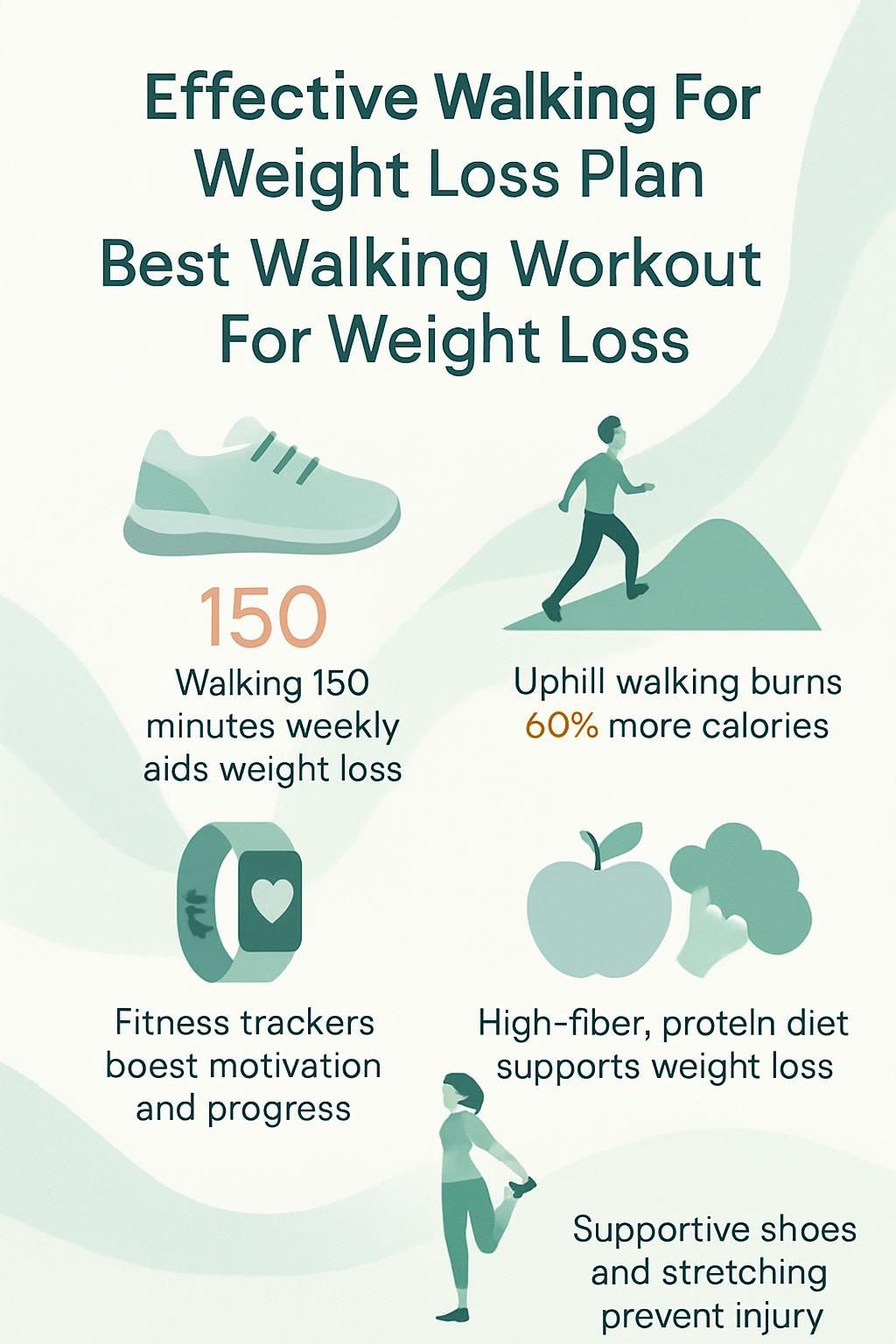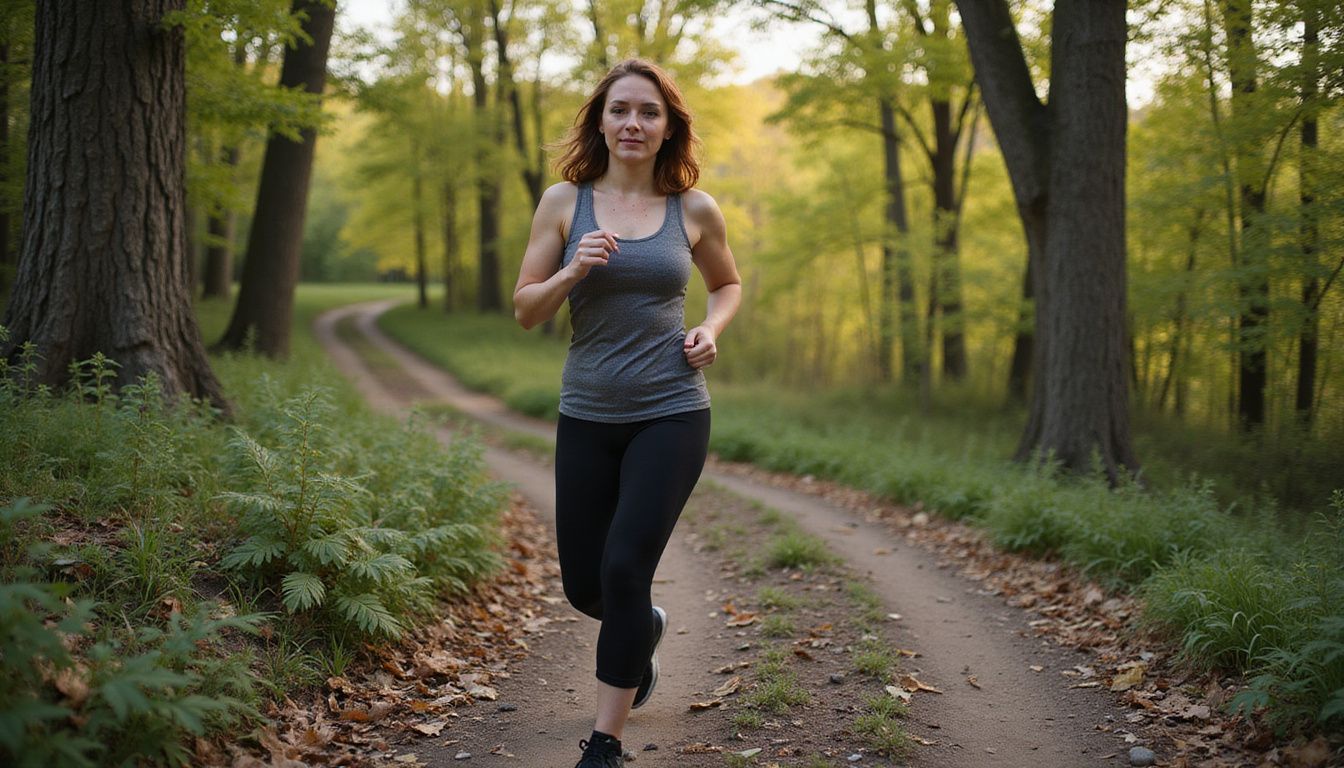Effective Walking For Weight Loss Plan: Best Walking Workout For Weight Loss
Our Nutrition Assistant AI Suite will transform your body. You will lose fat, get toned, and build muscle. Gain confidence and optimal health.
Weight loss can feel hard and confusing. A simple walking for weight loss plan gives you a clear starting point and steady progress. Research shows regular walking helps you burn calories, manage blood sugar, and lower the risk of heart disease.
In this guide, you will learn how to build a safe and effective walking workout for weight loss. You will get step-by-step advice, practical tools, and a schedule you can keep. Take the first step, then keep going.
Key Takeaways
- Walking at a brisk pace for 150 minutes per week, as advised by the American College of Sports Medicine and the CDC, supports steady weight loss and heart health.
- Adding hills, stairs, or interval bursts increases calorie burn. Uphill walking can raise energy use by as much as 60 percent compared with flat ground.
- Fitness trackers and apps such as Fitbit, Apple Watch, Garmin, and MapMyWalk help you track steps, heart rate, and routes, which boosts consistency.
- A balanced diet high in fiber and protein pairs well with walking. It helps control hunger and supports muscle recovery.
- Supportive shoes, a short warm-up, and post-walk stretching reduce injury risk and help you build a lasting routine.

Why Walking Works for Weight Loss

Walking is accessible, low cost, and fits into daily life. This low-impact activity helps you manage weight while improving many parts of your health.
How accessible and simple is walking as exercise?
You can walk almost anywhere, such as your neighborhood, a park, or a treadmill indoors. Many people prefer outdoor routes for fresh air and changing scenery.
Gear is simple, just supportive walking shoes and a water bottle for longer sessions. You can swap short car trips for brisk walks, park a little farther away, or take the stairs.
Step counters and phone apps make tracking easy. Pamela Wampler shared how small changes add up, she lost 50 pounds after replacing evening wine with daily walks.
Experts recommend walking for beginners because it fits most schedules. Splitting walks into two daily sessions may burn more calories than one longer session, based on an Obesity journal study from 2015.
After dinner every night, I’d slip on my sneakers and walk around the block instead of reaching for another glass of wine, said Pamela Wampler about her weight loss journey.
There is no need for specialized training or a personal trainer to start. The American College of Sports Medicine includes walking among effective options for weight control across fitness levels.
Why is walking considered a low-impact workout?
Walking places less stress on your joints than running or jumping. That makes it safer for knees, ankles, hips, and your lower back.
People with joint pain or chronic conditions often find walking manageable. Groups like the CDC and AARP view it as a good entry point to regular physical activity.
Treadmills offer controlled, low-impact sessions when weather is poor. Over time, you can increase duration or intensity with less injury risk than higher-impact sports.
What health and weight management benefits does walking offer?
Walking raises your daily calorie burn, which supports gradual fat loss. A weekly target of at least 150 minutes of brisk walking helps reduce body fat. Moving toward 250 minutes per week can lead to greater changes, according to ACSM guidelines.
Regular walking lowers risk factors tied to diabetes, heart disease, and some cancers. Even 20 minutes a day is linked with longer life.
Many people also notice better mood and reduced stress. Consistent aerobic exercise supports heart health and helps you keep weight off over time.
Setting Realistic Goals for Your Walking Plan
Clear goals make it easier to stay consistent and track progress. Realistic targets also protect you from doing too much too soon.
How do I assess my current fitness level?
Begin with 10 to 15 minutes per session at a brisk pace. If new to exercise, try two or three short walks per week and note how you feel.
Check your breathing and energy, and pay attention to how clothing fits over time. These simple signs often show progress before the scale does.
The Borg Rating of Perceived Exertion, or RPE, helps you judge effort. Aim for 12 to 14, which feels somewhat hard. To estimate maximum heart rate, subtract your age from 220. Try to walk at 60 to 70 percent of that number.
Log your energy and comfort at the start, middle, and end of a 31-day plan. Talk with your healthcare professional before starting if you have medical concerns. Starting with shorter walks and adding minutes each week helped me build confidence without injury.
Why aim for at least 150 minutes of walking per week?
ACSM, the American Heart Association, and the CDC recommend 150 minutes per week of moderate-intensity activity. Brisk walking for 30 minutes on most days meets this target.
This level supports heart health, improves fitness, and can aid diabetes management. Many people find five 30-minute walks each week practical and sustainable.
Using a fitness tracker or app often boosts motivation. Seeing your time and steps climb can keep you committed week after week.
How should I increase walking duration and intensity safely?
Gradual changes protect your joints and keep motivation high. Use these steps to progress safely.
- Start with 10 to 15 minutes if you are new. Let muscles and joints adapt before adding time.
- Increase time or distance by up to 20 percent every two weeks. For example, move from 15 to 18 minutes after two weeks.
- Work toward 30-minute sessions several days per week. This aligns with common physical activity guidelines.
- Adjust intensity or duration, not both at once, to lower injury risk.
- Split longer sessions into shorter bouts during the day if needed; shorter walks still build endurance.
- Warm up for five minutes at an easy pace before you speed up; warm muscles perform better.
- Include rest or active recovery days between hard efforts; recovery helps you stay consistent.
- Watch heart rate and perceived effort during brisk or interval walks. Ease up if breathing feels too hard.
- Track distance, time, route, terrain, and shoe type; data helps you see patterns and avoid setbacks.
- Walking with a friend increased my motivation and made new routes more fun.
Creating a Walking Schedule
A simple schedule turns good intentions into action. Structure keeps you consistent, even on busy days.
How can I break my weekly walking goal into daily sessions?
Divide your weekly goal into small, doable chunks. Build in flexibility so life does not derail your plan.
- Target 150 minutes per week. That equals 30 minutes, five days per week.
- Start with non-consecutive days, such as Monday, Wednesday, Friday, Saturday, and Sunday, to allow recovery.
- Use a calendar or app to log walks and track streaks.
- Split 30 minutes into two 15-minute sessions on busy days. Research in the Obesity journal supports the benefits of shorter bouts.
- Adjust session length based on energy, weather, or schedule. Flexibility keeps the plan realistic.
- Mix steady walks with one interval session each week for extra cardio and calorie burn.
- Invite a friend or family member. Having a partner helps with accountability and enjoyment.
Breaking the week into daily sessions makes goals feel achievable and helps you lose weight by walking in a steady, controlled way.
Why is 30 minutes of walking five days a week recommended?
This pattern lines up with the 150-minute guideline. It also builds a habit without draining your energy.
Studies show people stick with this schedule better than longer, less frequent workouts. It allows time for rest, which helps prevent injuries and burnout.
Thirty minutes fits around work, school, or a podcast. Last year, pairing daily walks with a healthy diet helped me lose about two pounds per week while keeping stress low.
How can changing walking times help maintain motivation?
Rotating your walking times can refresh your routine. Sunrise walks feel quiet and calm, while evening walks are cooler during summer.
Use a habit journal to track energy and mood at different times. Choose the slots where you feel strong and consistent.
If heat or rain ruins your plan, shift to another window in the day. Midday walks with a friend can add social support and keep you on track for 150 minutes each week.
Enhancing Your Walking Workout
Once a base is set, small changes in speed, incline, or intervals help you burn more calories without a full program overhaul.
How fast should I walk to burn more calories?
Walk at a brisk pace to raise calorie burn. For many people, that is close to 4 miles per hour. You should be able to talk, but not sing a full song.
A 155-pound person burns about 140 calories in 30 minutes at this speed. Keep your heart rate at about 60 to 70 percent of your maximum for a solid moderate intensity.
Short speed bursts, called intervals, can break plateaus. Track steps with a wearable or app to nudge daily totals higher. Mixing brisk walking with brief faster bouts kept my energy high and progress steady.
How do hills or stairs add resistance to walking workouts?
Uphill walking recruits more muscle fibers, which raises effort and calorie burn. Research suggests hills can increase energy use by up to 60 percent compared with flat ground.
Inclines strengthen your legs, glutes, and core. They also build endurance that carries into everyday life.
Start with gentle hills or a small treadmill incline. Add steeper climbs once your joints feel ready, and increase gradually to avoid injury.
What is interval training and how can it improve walking?
Interval training alternates faster bursts with easier recovery periods. For example, walk briskly for 60 seconds, then return to your normal pace for two minutes. Repeat for 10 to 20 minutes.
This method raises your heart rate and calorie burn without a long workout. It can help you push past weight loss plateaus and improve endurance.
Build a base of steady walking first, then add intervals one or two days per week. Pair intervals with smart nutrition to support recovery and results.
Tools to Track Your Progress
Tracking gives you feedback you can act on. Data turns vague goals into measurable steps.
What are the best fitness trackers or apps for walking?
Fitbit, Apple Watch, and Garmin devices track steps, heart rate, and pace. Many include GPS to map routes and set reminders.
Apps like Google Fit, MapMyWalk, and Pacer log daily steps and time. Some can sync with calendars for planning and with nutrition apps for simple meal tracking.
Choose a device that fits comfortably and matches your budget. Pedometers offer simple step counts if you prefer fewer features. My Apple Watch helped me monitor distance, intensity, and streaks, which kept me consistent.
How do I keep an effective log of my walking activities?
Use a printable calendar or digital log to note each session. Include duration, intensity, route, and terrain, such as flat or hills.
Keep a brief habit journal. Record mood, energy, and breathlessness right after your walk.
Weigh yourself weekly and note changes next to your walking entries. Many apps export data so you can review patterns. Simple notes like felt tired today or added sunscreen made it easier to adjust my plan and see progress.
How can I monitor weight changes alongside my walking plan?
Weigh in once per week at the same time using the same scale. Daily weigh-ins can be misleading because of normal fluid shifts.
Track how clothing fits and how hard you breathe on hills. These non-scale signs often confirm progress during plateaus.
Apps that combine steps, heart rate, and weigh-ins give a complete view. I noticed my jeans got looser before the scale moved, which kept me motivated. Celebrate milestones with non-food rewards like new socks or a hat for sun protection.
Sample Walking Plan for Beginners
This simple three-week outline builds stamina without overwhelming your schedule. Make small adjustments based on comfort and recovery.
What does a Week 1 walking plan look like?
Start with three brisk walks of 10 minutes each. Another option is 20-minute walks on Monday, Wednesday, and Friday, plus 30 minutes on Saturday.
Warm up with five easy minutes before each session to protect joints. Stay at a moderate intensity where you can talk, but full conversation is tough.
Choose safe, enjoyable routes to build consistency. Take at least one rest day or do gentle stretching. Log time and perceived effort after every session to see steady changes.
How do I increase walking time in Week 2?
Add one more session compared with Week 1. Aim for four walks this week, such as 15, 12, 15, and 12 minutes. Another approach is three 25-minute sessions on Monday, Wednesday, and Friday, plus 35 minutes on Saturday.
Increase total weekly time by up to 20 percent for safe progress. If you feel good, add short intervals or gentle hills once or twice this week. Keep at least one rest day for recovery before moving on.
How should I extend my sessions by Week 3?
Plan five walks with session lengths of 18, 15, 18, 15, and 15 minutes. Try new routes, such as a local park or a path with mild hills.
Add brief brisk intervals or a small incline on some days. Track time, distance, and intensity in your app or notebook. If soreness appears, scale back for a day.
Mixing locations kept me engaged and made it easier to stick to my plan. Light strength exercises can help you approach a steady 30-minute walk by the end of the week.
Nutrition Tips to Pair with Your Walking Plan
Walking and smart nutrition work better together. Small, steady changes beat extreme diets that are hard to sustain.
What constitutes a healthy, balanced diet for weight loss?
Build meals around vegetables, fruits, lean protein, whole grains, and healthy fats. Aim for a calorie deficit while still meeting your nutrient needs.
Higher fiber and protein increase fullness and support muscle repair. Limit processed foods and sugary snacks that can trigger hunger later.
Smaller, frequent meals can help control appetite. For example, grilled chicken, brown rice, and broccoli with a handful of nuts offers protein, fiber, and healthy fats. Planning meals in advance keeps you aligned with your walking plan.
How do I monitor caloric intake to support walking efforts?
Use a nutrition app to log everything you eat. This shows your true intake and reveals patterns that slow progress.
Measure portions with a kitchen scale or measuring cups to improve accuracy. Compare calories consumed with calories burned from walking, but avoid cutting too low. Too few calories can drain energy and stall fat loss.
Include a small snack before or after longer walks to prevent fatigue. Adjust intake as your weight changes so progress stays steady.
Why is hydration important before, during, and after walking?
Water helps your muscles contract and your joints move smoothly. It also reduces cramps and dizziness during exercise.
Drink water before starting. Bring a bottle for longer walks or hot weather. Pale yellow urine is a simple sign of good hydration.
Rehydrate after each walk to support recovery. Skip sugary drinks that add empty calories, and adjust how much you drink based on heat and intensity.
Preventing Injuries While Walking
Smart prep keeps your walks pain-free. A few protective habits make a big difference over months and years.
What type of shoes should I wear for walking?
Choose supportive shoes that fit well and cushion each step. Good arch support reduces strain during longer sessions.
Breathable materials help keep feet cool and dry. Replace shoes regularly because worn-out soles increase injury risk.
Match footwear to terrain. Trail routes need better traction. Try new pairs on a short walk before committing to longer ones. Specialty stores can help with fitting if needed.
How do I warm up properly before walking?
Start with five minutes at an easy pace. This increases blood flow and primes your heart and muscles.
Add gentle dynamic moves like butt kicks, high knees, ankle circles, and hip circles. Focus on posture with relaxed shoulders and an engaged core.
Finish your warm-up before moving to brisk or uphill walking. A clear warm-up reduces strain and improves performance.
Why is stretching important after walking?
Stretching after your walk eases stiffness and soreness. It also supports flexibility and joint range of motion.
Hold each stretch for 15 to 30 seconds without bouncing. Focus on calves, hamstrings, quadriceps, and hips.
Consistent post-walk stretching lowers the chance of overuse issues. Light yoga or mobility work can enhance recovery and keep you ready for the next session.
Advanced Tips for Maximizing Calorie Burn
Once your base is solid, these advanced tactics can lift results while keeping walks fresh and engaging.
How can weighted clothing or backpacks increase calorie burn?
Wearing a light weight vest or backpack adds resistance. Adding about 10 percent of your body weight can increase energy use by up to 13 percent.
Start light on flat routes, then build slowly. Watch posture and comfort, and remove weight if you feel pain.
Alternate weighted and unweighted days for variety. Strength gains from these sessions can support better walking form.
Why include strength training on non-walking days?
Strength work helps maintain muscle, which raises your daily calorie burn. A simple 10-minute circuit can include squats, bridges, plank to downward dog, seated twists, knee raises with back leg lifts, and calf raises.
No special equipment is required. Preserving muscle while losing fat can prevent plateaus and improves walking efficiency.
Two or three sessions per week are often enough. I noticed less fatigue on longer walks after three weeks of basic home strength work. Yoga or Pilates can add flexibility benefits.
How can exploring new trails boost my walking routine?
New routes add variety and challenge. Trails change terrain and incline, which recruits more muscles and increases focus.
Uneven surfaces test balance and coordination. Nature walks can also lower stress more than city sidewalks.
Some studies show uneven ground can boost calorie burn by up to 28 percent compared with flat surfaces. Plan your route and distance ahead of time for safety and accurate logging.
Mental and Emotional Benefits of Walking
Walking helps your body and your mind. A steady routine can lift mood, sharpen focus, and reduce stress.
How does walking improve mood and reduce stress?
Physical activity triggers endorphins, which can improve mood and ease anxiety. Walking outdoors may add extra stress relief through light, air, and scenery.
Social walks offer support and encourage consistency. Short walks during the workday create mental breaks that lower tension.
Pair your walks with a weekly reflection prompt. Writing down how you feel after sessions can reinforce positive habits.
Can walking boost mental clarity and focus?
Walking increases blood flow to the brain, which can sharpen thinking. Mindful walking, paying attention to breath and surroundings, can refresh attention.
One study from the University of Illinois found a 20-minute brisk walk can improve cognitive performance by about 10 percent. Even a quick 10-minute nature walk can reduce mental fatigue.
I often use short walks between writing tasks. They clear my head and make the next session easier. Track how your focus changes after different walk times to find your best window.
How does walking support long-term fitness adherence?
Walking is gentle on the body, which makes it easier to stick with over months and years. Setting simple goals, such as 30 minutes five days a week, builds confidence.
Friends, clubs, and group walks increase accountability. Changing routes and times prevents boredom.
Habit journals help you track progress and celebrate wins. Folding walking into daily routines, like lunch breaks or school pickup, makes it sustainable.
Frequently Asked Questions About Walking for Weight Loss
These concise answers address common concerns so you can move forward with clarity and confidence.
How fast should I walk to lose weight?
Walk at a brisk pace where talking is possible but full conversation is hard. For many people, this is about 4 miles per hour.
A 155-pound person may burn around 140 calories in 30 minutes at that pace. Target 60 to 70 percent of your maximum heart rate. Estimate maximum as 220 minus your age.
Use the Borg RPE scale and aim for 12 to 14, or somewhat hard. Add short intervals of faster walking for extra calorie burn.
Can walking alone help me lose weight?
Yes, especially with consistency. Aim for at least 150 minutes per week at a moderate intensity.
Brisk walking burns meaningful calories, and the weekly total adds up over time. Pair walking with a balanced diet for the best results.
Gradually increase pace or duration as fitness improves. Steady changes help you avoid injury and plateaus.
What should I do if I hit a weight loss plateau?
Increase your total weekly minutes to 200 to 250. Add intervals, hills, or stairs to raise intensity.
Change routes or terrains to challenge new muscle groups. Track steps and weigh in weekly to see trends.
Review your diet for hidden calories. Focus on whole foods and adequate protein and fiber to support your walking plan.
Conclusion
A simple walking plan can help you lose weight and feel better day to day. Start with short, brisk sessions and build time and intensity slowly.
Wear supportive shoes, warm up, and stretch after walking to prevent injury. Use a tracker to record time, steps, and heart rate, then adjust as needed.
Pair your walking workout for weight loss with balanced meals and steady hydration. Stay consistent, vary your routes and pace, and you will see progress in both health and mood.
FAQs
1. How effective is walking for weight loss compared to other workouts?
Walking can support weight loss when paired with a balanced diet and consistent routine. Research from the Centers for Disease Control and Prevention shows that brisk walking burns about 150 calories in 30 minutes for a person weighing around 155 pounds. While running or cycling may burn more calories per minute, walking remains accessible and sustainable for most people.
2. What is the best walking workout plan for losing weight?
A structured plan often includes intervals of fast-paced strides mixed with moderate-speed walks. For example, alternating three minutes of brisk movement with two minutes at a slower pace over thirty to forty-five minutes helps increase calorie use and improve cardiovascular health. Studies suggest interval training boosts fat reduction more than steady-state exercise.
3. How many days per week should I walk to see results?
Most experts recommend at least five days each week, aiming for thirty to sixty minutes per session at a moderate or vigorous intensity level. The American Heart Association supports this frequency as it aligns with improved metabolic rates and sustained fat burning.
4. Can personal experience help tailor an effective walking program?
Personal feedback plays an important role in shaping your routine; tracking distance, speed, and how you feel during each session allows adjustments based on progress or comfort level. For instance, after following a four-week interval-based schedule myself, I noticed increased stamina along with gradual weight change.
Summary: Walking offers measurable benefits as part of a comprehensive approach to losing body mass; combining evidence-backed strategies like interval sessions and regular schedules leads to better outcomes than unplanned activity alone.







